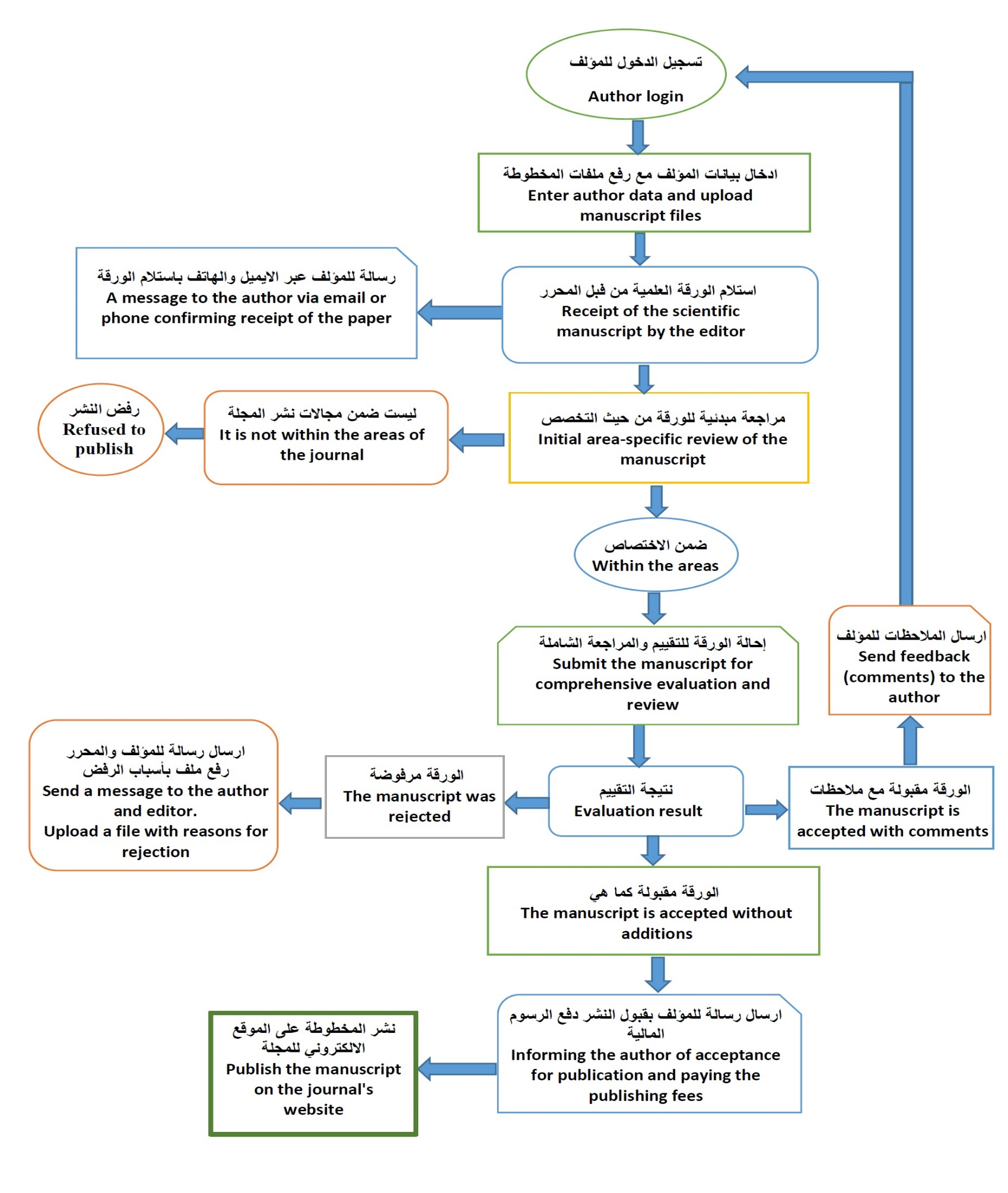Home < Evaluation stages and steps
Evaluation stages and steps
- The researcher opens his own electronic account on the journal’s website and then submits the manuscript to the editorial board through this system, or the researcher can send his research to the editorial board via e-mail (stjeditor1@gmail.com), and the researcher can easily send the scientific manuscript in Microsoft Word format via this system or e-mail, and then enter his personal and scientific data and upload his research. He will receive an e-mail message stating that the research has been received. The researcher also needs to send a signature acknowledging the intellectual property ownership of the research.
- Reviewing in the journal takes place within the scientific paper itself, so that comments and inquiries about it are placed in the side dialog boxes and sent to the author after the reviewing process is completed. This method would make it easier for researchers and reviewers, speed up the reviewing process, and save time and effort for everyone.
- The reviewer and evaluator is registered as one of the magazine’s accredited experts, and the reviewer and evaluator can easily enter the magazine’s website, and can enter his personal and academic data and his bank account number through a special electronic form located in the magazine’s electronic forum, to be among a large list of reviewer and evaluators.
- In the form there are several data that the reviewer and evaluator must fill out, including his exact specialty upon registration, his phone number, and his e-mail. This specification helps the editor-in-chief when selecting the reviewer and evaluator for evaluation, and all information is subject to modification by the reviewer and evaluator at any time, and the editor-in-chief can view all of the reviewer and evaluator’s data.
- The list of reviewer and evaluators is subject to review and editing every period so that those distinguished by quality, accuracy and speed of completion are selected from among them.
- After the initial review and recommendation to accept the research for evaluation, the editor-in-chief, in consultation with the members of the editorial board, selects two reviewers for one research. The research is subject to confidential evaluation to determine its suitability for publication, and the researcher is committed to taking into account the reviewers’ comments.
- The research is sent to the reviewer and evaluators via (the system) and the reviewer and evaluators are notified via a text message on the mobile phone.
- The research to be reviewed appears in the reviewer’s account in the system after the editor-in-chief sends it to him. The research appears in (Word) and (PDF) format, the reviewer does not see the name of the researcher, and vice versa, the researcher does not see the name of the reviewer.
- There is a ready-to-review form available on the journal’s website, which contains several instructions for the evaluator, which the reviewer and evaluator can use as a guide for the evaluation process. The reviewer may attach a file of notes on the manuscript separately to the editor.
- The period of evaluation and review must not exceed three weeks, and the reviewer and evaluator must be informed of this, after which the reviewer and evaluator must respond either (acceptance), which is acceptance of the research for publication, or (acceptance on condition of modification), which is acceptance of the research for publication on the conditions of making some modifications to it, or (rejection). It is a recommendation to apologize for publishing the research.
- Sending a reminder to the reviewer and evaluator (10) days after receiving the research via a message on the mobile phone.
- When the referee sends his report, a message arrives to the editor-in-chief.
- Through the system, the researcher can inquire about the research, what was done about it, and is it under preliminary examination? Or under evaluation? Or under modification? Or about to be published? In what issue will it be published.
- In the event of a recommendation to “apologize for publishing the research,” the researcher will be notified via the “system” of “rejection of the research.
- In the event of a recommendation to “accept the research with conditions,” the researcher will be notified with a message via (the system) to make some amendments according to the referees’ reports and notes received from them, and then the research will be returned amended via (the system) as well.
- In the event of a recommendation to “accept the research for publication,” the researcher will be notified via the “system.” A “certificate” is written to him that the research has been accepted for publication.
- After receiving the evaluation, thanks are sent to the reviewer and evaluator via the “phone” and “system”, and the magazine administration transfers the “reward” to the reviewer and evaluators, notifies them of the transfer, and communicates with them to ensure receipt, and a copy of the transfer document is placed in the reviewer and evaluator’s account.
- Through the system, the reviewer and evaluator can review all the research that he previously reviewed.
- There will be a box in the system for the reviewer’s evaluation by the editor-in-chief, which includes: the quality of the review, and the timely response.

